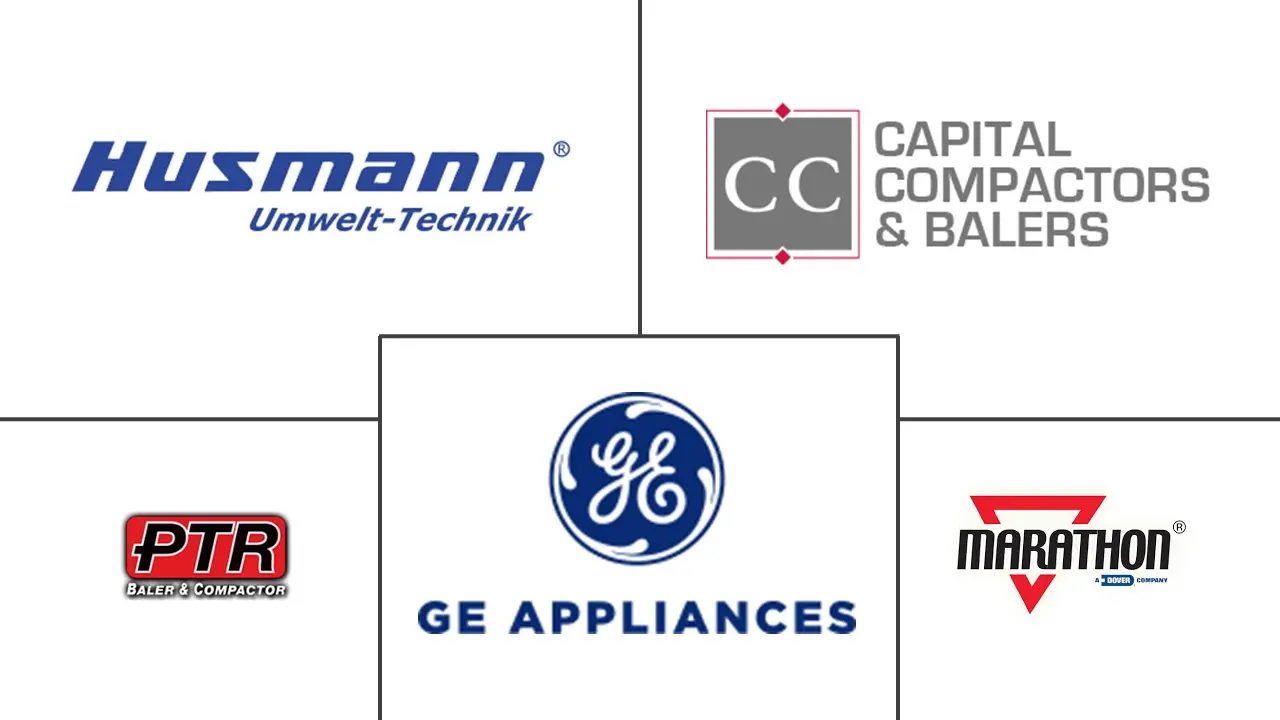Global Refuse Compactor Market Size and Share
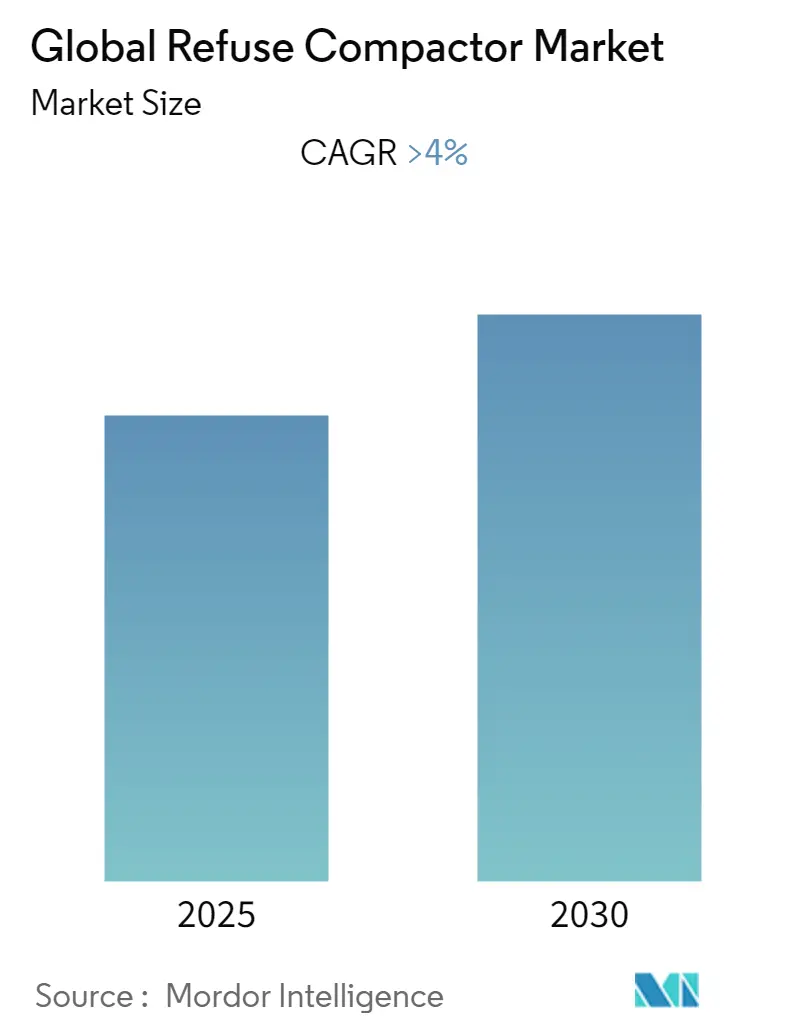
Global Refuse Compactor Market Analysis by Mordor Intelligence
The Global Refuse Compactor Market is expected to register a CAGR of greater than 4% during the forecast period.
Since the COVID-19 outbreak, nations have faced significant challenges with the generation, collection, treatment, and disposal of waste. One of the direct consequences of the pandemic has been a 40 percent increase in the global production of biomedical waste. The Central CPCB has also developed a COVID-19 Biomedical Waste Management app Covid19BWM to track biomedical waste management in the country.
Awareness about increased garbage collection services coupled with the introduction of programs such as Pay as you, Throw by waste management services across several cities is also anticipated to increase the demand for refuse compactors. The world generates approx. 2.01 billion tons of municipal solid waste annually. Out of which at least 33% that is not properly managed in an environmentally safe manner. Additionally, rising concerns related to limited spaces in landfills coupled with avoidance of burning waste in landfills due to harmful emission of gases are anticipated to increase the demand for refuse compactors. A key driver for the growth of the refuse compactor market size is the rise in the world's population and the subsequent increase in waste generation.
In recent years, waste management has been the focus of multiple central and state government initiatives. For instance, Swachh Bharat Mission (SBM) India's national cleanliness program promotes monitoring and implementation of municipal solid waste management plans by urban local bodies.
Global Refuse Compactor Market Trends and Insights
Asia-Pacific to Dominate the Market
The Asia-Pacific region is expected to increase in demand for the global refuse compactor market during the forecasting period. Most APAC countries are significantly expanding their spending on waste management systems, which leads to an increase in demand for the refuse compactor market. Due to the scarcity of dumping sites in the region compared to the garbage generated by largely populated countries like China and India, trash compression is needed.
The municipality has wide usage of the compactor in its day-to-day activities, the compactor is primarily used for compacting solid waste. The world bank has estimated that by 2025, between 2.2 billion to 2.5 billion tons of municipal solid waste (MSW) would need to be recycled in the Asia Pacific region, and to facilitate such requirements, the international solid waste association world congress has decided to adopt new recycling technologies and increase the capacity of existing recycling plants within the Asia Pacific region. Moreover, Asia Development Bank has come up with an initiative to provide financial support to the waste management program and promote social and economic development in the region, thus supporting the growth of the Asia Pacific refuse compactor market.
In February 2021, New Delhi Municipal Council, known as NDMC launched six compactors that are based on CNG to decrease pollution and make sure proper transportation and collection of household waste.
Therefore, owing to the above points, Asia-Pacific is expected to dominate the refuse compactor market during the period studied.
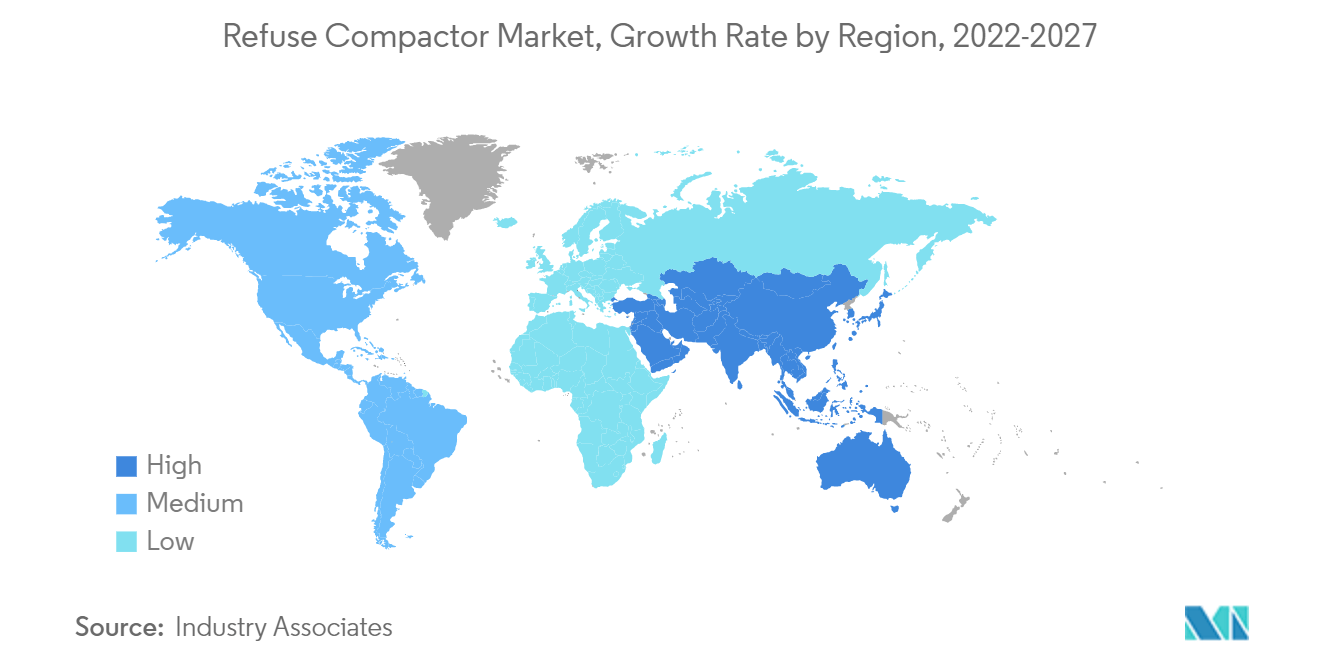
Demand for trash bags for refuse compactors
The Refuse Compactor is very useful in maintaining the trash for a longer period when compared with the conventional systems. This long-time holding of the trash creates unhealthy odors that are one of the restraining factors of the Refuse Compactor. The Refuse Compactor requires special bags as the regular bags are not designed for the extreme pressure that the trash goes through when compacted.
Using bags specially manufactured for trash compactors is required to withstand the immense force the compactor uses to compact the garbage. Regular trash bags were not designed for the amount of force trash compactors use. The size of the bag depends on the compactor's manufactured width, which is usually between 15 and 18 inches (38 and 46 cm). Trash bags for compactors are specifically designed to easily carry 30, 40, or even 50 pounds of trash.
Low density (LDPE) can liners are more suitable for yard trash, construction debris, and kitchen trash. Low-density can liners are the ideal bag for handling trash compactor needs.
Due to the extreme pressure of the compactor, bags designed to handle the force are necessary. These are made at least partially of plastic and resist moisture and tearing. 117.1 million Americans used the Hefty brand in 2021.
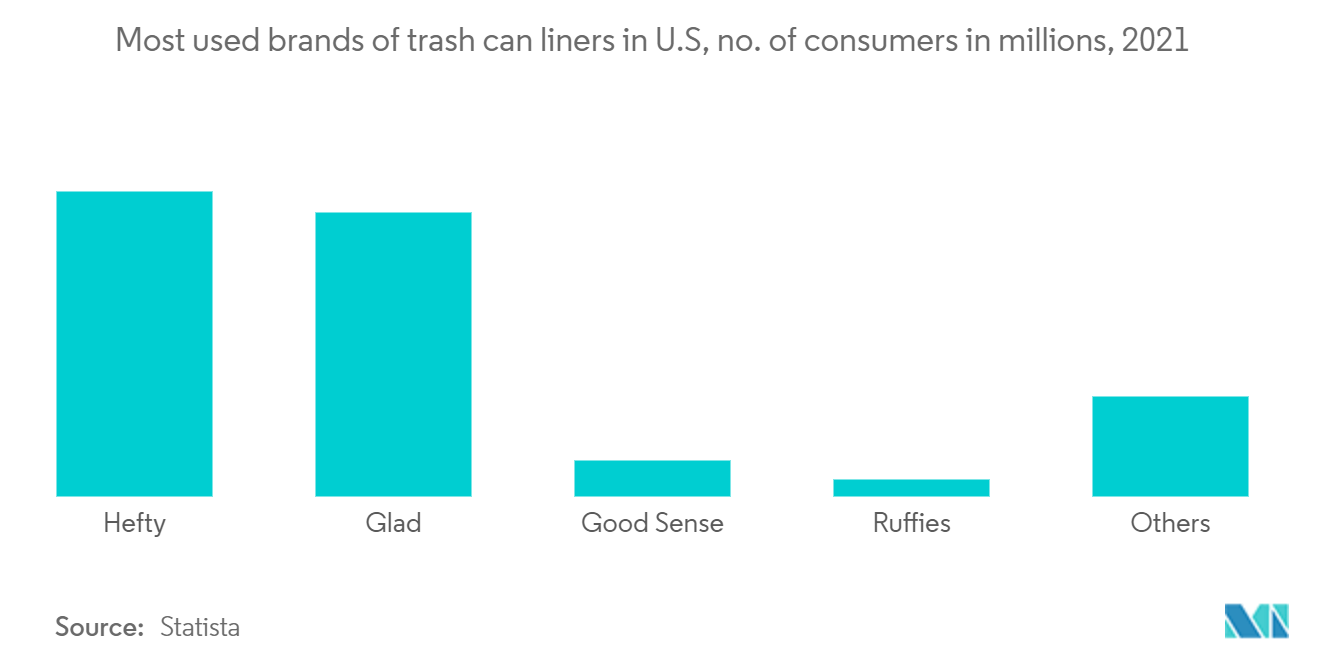
Competitive Landscape
The report covers major international players operating in the global refuse compactor market. The market is highly fragmented in nature, with large companies claiming significant market share. The primary factor driving demand in the global refuse compactor market is municipalities' policy to reduce wastage and the scarcity of landfill space.
Some of the prominent manufacturers involved in the global refuse compactors market have also been found to be involved in the introduction of energy-efficient refuse compactors. Ecube Labs has introduced trash compactors that run on solar energy. These types of compactors can hold more waste than non-compacting bins and also reduce collection frequency. The SmartEnergy compactor's electronic controls are powered with solar energy which is manufactured by Wastequip.
Some of the key players in the global refuse compactor market are GE Appliances, Husmann Umwelttechnik GmbH, PTR Baler & Compactor, Marathon Equipment Company, Capital Compactors Ltd, Compactor Management Company, Genesis Waste Handling Private Limited, Precision Machinery Systems, ACE Equipment Company, Wastequip LLC. etc.,
Global Refuse Compactor Industry Leaders
-
GE Appliances
-
Husmann Umwelttechnik GmbH
-
PTR Baler & Compactor
-
Marathon Equipment Company
-
Capital Compactors Ltd
- *Disclaimer: Major Players sorted in no particular order
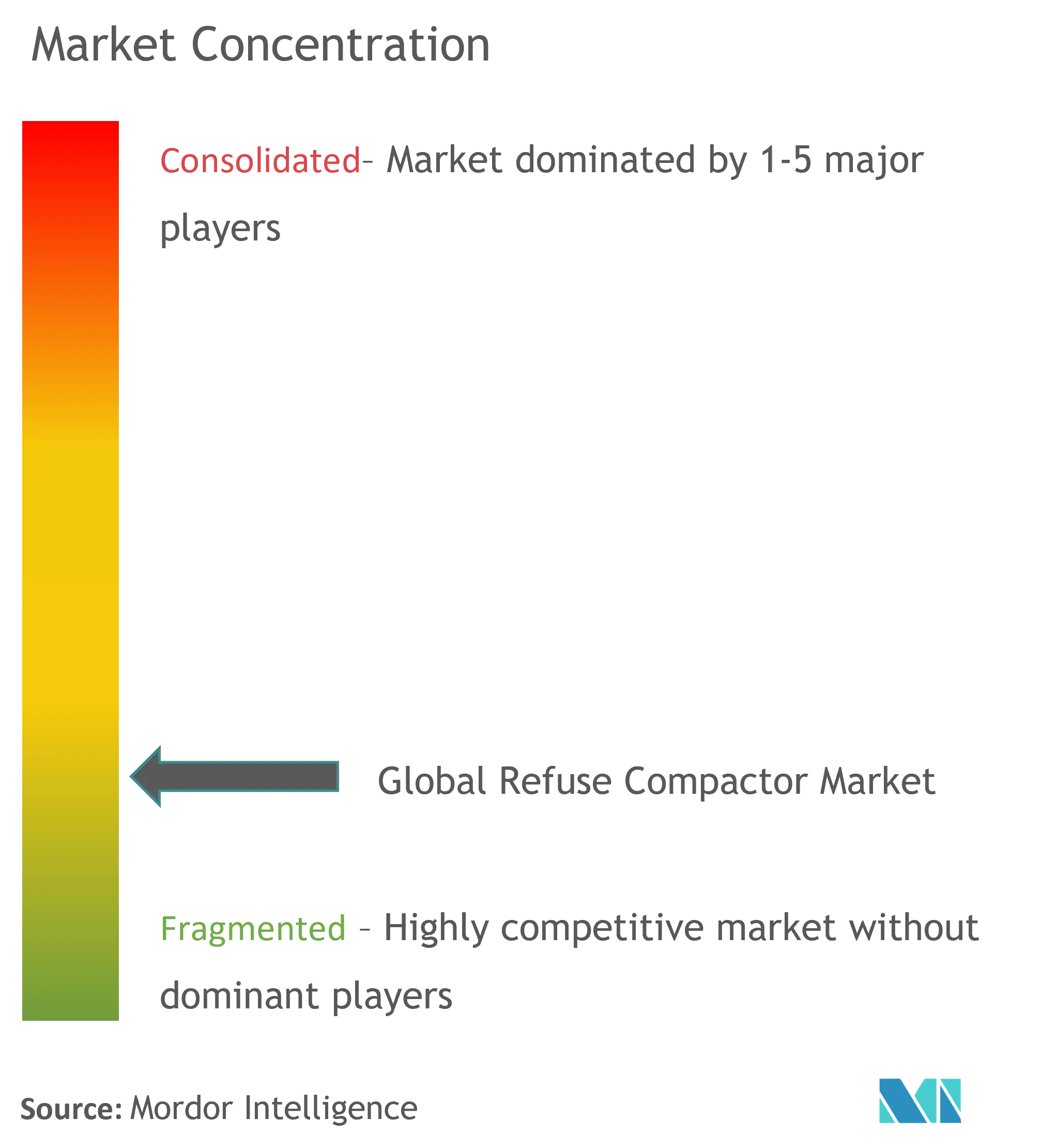
Recent Industry Developments
February 2022: The New Town Kolkata Development Authority has planned to set up 15 compactor stations in different locations across New Town to facilitate a daily waste collection and disposal system. The compactor stations will be constructed at an estimated cost of about Rs 4.1 crore.
September 2021: Wastequip, the leading North American manufacturer of waste handling equipment announced the launch of wasteware, a cloud technology solutions suite for the waste and recycling industry. Wasteware is the value-added digital partner for products, equipment, and services.
Global Refuse Compactor Market Report Scope
A refuse compactor, also known as a garbage or trash compactor, is a modern machine that collects and compression stroke garbage, reducing the waste volume and providing significant savings on waste disposal.
Global Refuse Compactor Market is Segmented By Product Type(Portable and Stationary), By Waste Type(Dry Waste and Wet Waste), By Application(Residential, Agricultural, Municipal, Commercial and Industrial), By Geography(North America, Latin America, Asia-Pacific, Middle East, and Africa, Europe and Rest of the World).
The report offers the market sizes and forecasts for the Global Refuse Compactor market in value (USD) for all the above segments and the impact of COVID-19 on the market.
| Portable |
| Stationary |
| Dry Waste |
| Wet Waste |
| Residential |
| Agricultural |
| Municipal |
| Commercial |
| Industrial |
| North America |
| Latin America |
| Asia-Pacific |
| Middle-East and Africa |
| Europe |
| Rest of the World |
| By Product Type | Portable |
| Stationary | |
| By Waste Type | Dry Waste |
| Wet Waste | |
| By Application | Residential |
| Agricultural | |
| Municipal | |
| Commercial | |
| Industrial | |
| By Geography | North America |
| Latin America | |
| Asia-Pacific | |
| Middle-East and Africa | |
| Europe | |
| Rest of the World |
Key Questions Answered in the Report
What is the current Global Refuse Compactor Market size?
The Global Refuse Compactor Market is projected to register a CAGR of greater than 4% during the forecast period (2025-2030)
Who are the key players in Global Refuse Compactor Market?
GE Appliances, Husmann Umwelttechnik GmbH, PTR Baler & Compactor, Marathon Equipment Company and Capital Compactors Ltd are the major companies operating in the Global Refuse Compactor Market.
Which is the fastest growing region in Global Refuse Compactor Market?
Asia-Pacific is estimated to grow at the highest CAGR over the forecast period (2025-2030).
Which region has the biggest share in Global Refuse Compactor Market?
In 2025, the Asia-Pacific accounts for the largest market share in Global Refuse Compactor Market.
What years does this Global Refuse Compactor Market cover?
The report covers the Global Refuse Compactor Market historical market size for years: 2020, 2021, 2022, 2023 and 2024. The report also forecasts the Global Refuse Compactor Market size for years: 2025, 2026, 2027, 2028, 2029 and 2030.
Page last updated on:
Global Refuse Compactor Market Report
Statistics for the 2025 Global Refuse Compactor market share, size and revenue growth rate, created by Mordor Intelligence™ Industry Reports. Global Refuse Compactor analysis includes a market forecast outlook for 2025 to 2030 and historical overview. Get a sample of this industry analysis as a free report PDF download.
